英语课程与教学论整理
- 格式:docx
- 大小:59.11 KB
- 文档页数:3

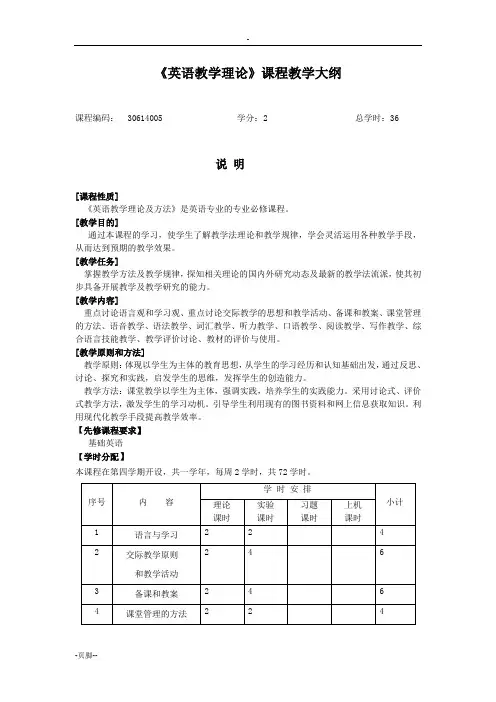
《英语教学理论》课程教学大纲课程编码: 30614005 学分:2 总学时:36说明[课程性质]《英语教学理论及方法》是英语专业的专业必修课程。
[教学目的]通过本课程的学习,使学生了解教学法理论和教学规律,学会灵活运用各种教学手段,从而达到预期的教学效果。
[教学任务]掌握教学方法及教学规律,探知相关理论的国内外研究动态及最新的教学法流派,使其初步具备开展教学及教学研究的能力。
[教学内容]重点讨论语言观和学习观、重点讨论交际教学的思想和教学活动、备课和教案、课堂管理的方法、语音教学、语法教学、词汇教学、听力教学、口语教学、阅读教学、写作教学、综合语言技能教学、教学评价讨论、教材的评价与使用。
[教学原则和方法]教学原则:体现以学生为主体的教育思想,从学生的学习经历和认知基础出发,通过反思、讨论、探究和实践,启发学生的思维,发挥学生的创造能力。
教学方法:课堂教学以学生为主体,强调实践,培养学生的实践能力。
采用讨论式、评价式教学方法,激发学生的学习动机。
引导学生利用现有的图书资料和网上信息获取知识。
利用现代化教学手段提高教学效率。
【先修课程要求】基础英语【学时分配】本课程在第四学期开设,共一学年,每周2学时,共72学时。
[课程教材及必要参考书]教材:王蔷《英语教学法教程》高等教育出版社 2000年。
参考书: English Language Teaching Methodology 外语教学与研究出版社 2001年。
Aspects of Language Teaching 上海外语教育出版社 2000年。
大纲内容第一部分语言与学习[教学目的和要求]教学目的:了解语言教学的相关问题教学要求:掌握语言教学的基本原理[内容提要]第一节一、学习语言的目的二、语言观三、语言学习观[教学重点与难点问题]教学重点:语言观、语言学习观教学难点:语言学习观[复习思考题]1.How can one become a good language teacher?2.What are the qualities of a good language teacher?第二部分交际教学原则和教学活动[教学目的和要求]教学目的:交际教学法在教学中的实践教学要求:掌握交际教学法的教学方法[内容提要]第一节一、语言的实际使用和传统教学法二、语言能力的培养三、语言技能的形成四、交际教学活动[教学重点与难点问题]教学重点:语言的实际使用和传统教学法、语言能力的培养教学难点:语言技能的形成[复习思考题]1. How to conduct communicative activities in the English classroom?2. What are the relationship between language use in real life and traditional pedagogy?第三部分教案[教学目的和要求]教学目的:学习教案的写作方法教学要求:掌握教案的写作方法[内容提要]第一节一、教案的必要性二、写好教案的原则三、宏观教案和微观教案四、教案的组成[教学重点与难点问题]教学重点:写好教案的原则、教案的组成教学难点:宏观教案和微观教案[复习思考题]1. Which planning do we often make, macro planning or micro planning? Why?2. What are the components of a lesson plan?第四部分课堂管理[教学目的和要求]教学目的:学习有效的课堂管理方法教学要求:掌握有效的课堂管理方法[内容提要]第一节一、教师的作用二、学生分组三、课堂纪律[教学重点与难点问题]教学重点:教师的作用教学难点:课堂纪律[复习思考题]1.How can we maintain discipline in the classroom?2. What do you think the teacher does when he/she is a controller, an assessor, an organizer, a prompter, a participant and a resource-provider respectively?第五部分语音教学[教学目的和要求]教学目的:了解语音教学的教学过程教学要求:掌握语音教学的教学方法[内容提要]第一节一、语音的作用二、语音教学的目标三、语音的组成四、语音练习[教学重点与难点问题]教学重点:语音的组成、语音练习教学难点:语音练习、语调和重音[复习思考题]1.How can teachers help the students to practice pronunciation?2.If we should not require native-like pronunciation, What should be our realistic goals?第六部分语法教学[教学目的和要求]教学目的:了解语法教学的教学过程教学要求:掌握语法教学的教学方法[内容提要]第一节一、英语教学中语法的作用二、语法演练方法三、语法练习[教学重点与难点问题]教学重点:语法演练方法、语法练习教学难点:语法演练方法[复习思考题]1.What do you think about the belief that teaching grammar is less important for children than for adults?2. Which method do you like better, deductive method or inductive method?第七部分词汇教学[教学目的和要求]教学目的:了解词汇教学的教学过程教学要求:掌握词汇教学的教学方法[内容提要]第一节一、词汇和词汇积累二、新词的使用三、词汇的巩固四、词汇积累策略[教学重点与难点问题]教学重点:词汇和词汇积累、词汇的巩固教学难点:词汇的巩固[复习思考题]1.Can words be taught and learned most effectively in groups of words which are related to each other in meaning?2.How to present the word “grumble”?第八部分听力教学[教学目的和要求]教学目的:了解听力技能的教学过程教学要求:掌握听力技能的教学方法[内容提要]第一节一、听力较难得原因二、听力训练过程的特点三、听力教学的原则[教学重点与难点问题]教学重点:听力训练过程的特点、听力教学的原则教学难点:听力教学的原则[复习思考题]1.What are the common activities in teaching listening?2.What are the principles of teaching listening?第九部分口语教学[教学目的和要求]教学目的:了解口语技能的训练过程教学要求:掌握口语技能的教学方法[内容提要]第一节一、口语的特点二、口语练习的设置三、分组练习模式[教学重点与难点问题]教学重点:口语的特点、口语练习的设置教学难点:口语练习的设置[复习思考题]1. 1.What are the common activities in teaching speaking?2. What are the principles of teaching speaking?第十部分阅读教学[教学目的和要求]教学目的:了解阅读技能的教学过程教学要求:掌握阅读技能的教学方法[内容提要]第一节一、如何阅读二、如何选读三、阅读理解的技巧四、阅读教学的原则[教学重点与难点问题]教学重点:阅读理解的技巧、阅读教学的原则教学难点:阅读理解的技巧[复习思考题]1. 1.What are the common activities in teaching reading?2.What are the principles of teaching reading?第十一部分写作教学[教学目的和要求]教学目的:了解写作技能的教学过程教学要求:掌握写作技能的教学方法[内容提要]第一节一、写作的实际特点二、交际写作法三、写作的难点[教学重点与难点问题]教学重点:交际写作法、写作的难点教学难点:交际写作法[复习思考题]1. What are the common activities in teaching writing?2. What are the principles of teaching writing?第十二部分综合语言技能教学[教学目的和要求]教学目的:听、说、读、写四种技能的综合运用教学要求:掌握听、说、读、写四种技能的综合运用方法[内容提要]第一节一、四项基本技能的综合二、如何综合四项基本技能三、综合四项基本技能的限制[教学重点与难点问题]教学重点:四项基本技能的综合、如何综合四项基本技能?教学难点:如何综合四项基本技能[复习思考题]1.How can we integrate the four skills?2. What are the limitations of integrating the four skills?第十三部分教学评价[教学目的和要求]教学目的:语言教学中如何进行评估。


英语课程与教学论第二版课程内容一、引言随着全球化时代的到来,英语在国际交流中的地位日益重要。
英语课程与教学在我国教育体系中占有举足轻重的地位。
英语课程与教学论作为研究英语教育规律的一门学科,旨在探讨如何更好地实现英语教学目标,提高英语教育质量。
本文将从英语课程设计、英语教学方法、课堂教学策略、英语教学评价、教师专业发展等方面展开论述,以期为英语教育工作者提供有益的启示。
二、英语课程设计1.课程目标的确定英语课程目标的确定应遵循国家课程标准,结合各级教育特点和学生实际情况。
课程目标应注重培养学生听、说、读、写四项基本技能,提高学生的语言运用能力和跨文化交际能力。
2.课程内容的选取英语课程内容应贴近生活、实用性强,注重培养学生的实践能力。
课程内容的选取应充分考虑学生的兴趣、需求和发展水平,兼顾知识、技能和素质的培养。
3.课程评价的策略课程评价应注重过程与结果相结合,形成性评价和终结性评价相结合。
评价方式多样,如课堂观察、学生自评、同伴评价等,以全面了解学生学习状况,提高教学效果。
三、英语教学方法1.口语教学法口语教学法注重学生在实际语境中进行语言交流,提高学生的口头表达能力。
教师可通过组织课堂讨论、角色扮演等活动,让学生在实践中掌握英语口语。
2.听力教学法听力教学法着重培养学生的英语听力技能。
教师可利用多媒体教学手段,如录音、视频等,为学生提供丰富的听力素材,提高学生的听力水平。
3.阅读教学法阅读教学法旨在提高学生的英语阅读能力。
教师可通过讲解阅读策略、组织阅读活动等方式,帮助学生掌握阅读技巧,培养良好的阅读习惯。
4.写作教学法写作教学法关注学生书面表达能力的培养。
教师可通过指导写作技巧、提供写作示范等途径,引导学生完成不同类型的写作任务,提高写作质量。
四、课堂教学策略1.任务型教学法任务型教学法以任务为载体,让学生在完成任务的过程中学习英语。
教师设计具有挑战性、趣味性的任务,激发学生学习兴趣,提高课堂参与度。
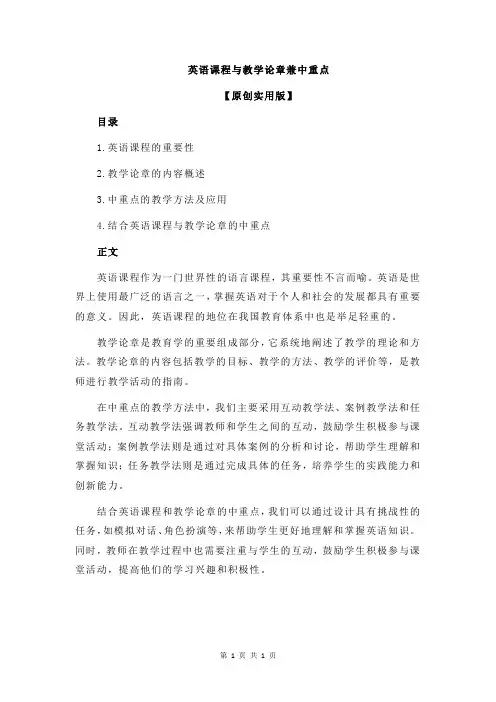
英语课程与教学论章兼中重点
【原创实用版】
目录
1.英语课程的重要性
2.教学论章的内容概述
3.中重点的教学方法及应用
4.结合英语课程与教学论章的中重点
正文
英语课程作为一门世界性的语言课程,其重要性不言而喻。
英语是世界上使用最广泛的语言之一,掌握英语对于个人和社会的发展都具有重要的意义。
因此,英语课程的地位在我国教育体系中也是举足轻重的。
教学论章是教育学的重要组成部分,它系统地阐述了教学的理论和方法。
教学论章的内容包括教学的目标、教学的方法、教学的评价等,是教师进行教学活动的指南。
在中重点的教学方法中,我们主要采用互动教学法、案例教学法和任务教学法。
互动教学法强调教师和学生之间的互动,鼓励学生积极参与课堂活动;案例教学法则是通过对具体案例的分析和讨论,帮助学生理解和掌握知识;任务教学法则是通过完成具体的任务,培养学生的实践能力和创新能力。
结合英语课程和教学论章的中重点,我们可以通过设计具有挑战性的任务,如模拟对话、角色扮演等,来帮助学生更好地理解和掌握英语知识。
同时,教师在教学过程中也需要注重与学生的互动,鼓励学生积极参与课堂活动,提高他们的学习兴趣和积极性。
第1页共1页。
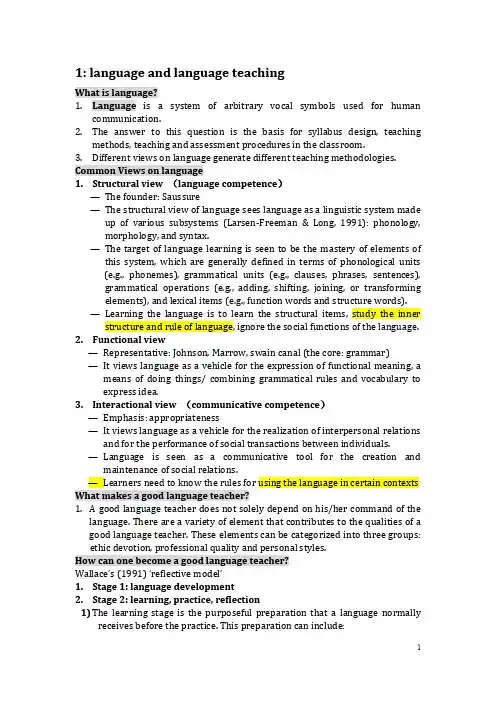
1: language and language teachingWhat is language?nguage is a system of arbitrary vocal symbols used for humancommunication.2.The answer to this question is the basis for syllabus design, teachingmethods, teaching and assessment procedures in the classroom.3.Different views on language generate different teaching methodologies. Common Views on language1.Structural view (language competence)—The founder: Saussure—The structural view of language sees language as a linguistic system made up of various subsystems (Larsen-Freeman & Long, 1991): phonology, morphology, and syntax.—The target of language learning is seen to be the mastery of elements of this system, which are generally defined in terms of phonological units(e.g., phonemes),grammatical units (e.g., clauses, phrases, sentences),grammatical operations (e.g., adding, shifting, joining, or transforming elements), and lexical items (e.g., function words and structure words).—Learning the language is to learn the structural items, study the inner structure and rule of language, ignore the social functions of the language.2.Functional view—Representative: Johnson, Marrow, swain canal (the core: grammar)—It views language as a vehicle for the expression of functional meaning, a means of doing things/ combining grammatical rules and vocabulary to express idea.3.Interactional view (communicative competence)—Emphasis: appropriateness—It views language as a vehicle for the realization of interpersonal relations and for the performance of social transactions between individuals.—Language is seen as a communicative tool for the creation and maintenance of social relations.—Learners need to know the rules for using the language in certain contexts What makes a good language teacher?1. A good language teacher does not solely depend on his/her command of thelanguage. There are a variety of element that contributes to the qualities of a good language teacher. These elements can be categorized into three groups: ethic devotion, professional quality and personal styles.How can one become a good language teacher?Wallace’s (1991) ‘reflective model’1.Stage 1: language development2.Stage 2: learning, practice, reflection1)The learning stage is the purposeful preparation that a language normallyreceives before the practice. This preparation can include:Learning from others’ experienceLearning the received knowledgeLearning from one’s own experiences2)The practice stage (2 senses)Pseudo practice: short period of time assigned to do teaching practice as part of one’s pre-service education, usually under the supervision of instructorsThe real classroom teaching:what a teacher undertakes after he/she finishes formal education3)Teachers benefit from practice if they keep on reflecting on what they havebeen doing3.Goal: professional competence2: theory of language learning and language learners1.Fluency1)Different levels of fluency:[1]time-filling[2]quality of speech[3]appropriacy of speech[4]aesthetic capability2)In terms of second or foreign language environment, fluency means a level ofproficiency in communication (Richards, 1992).3)Four kinds of abilities:[1]the ability to produce spoken language with ease;[2]the ability to speak with a good but not necessarily perfect command ofintonation, vocabulary, and grammar;[3]the ability to communicate ideas effectively;[4]the ability to produce continuous speech without causingcomprehensible difficulties or a breakdown in communication.2.Accuracy1)Accuracy refers to the ability to produce grammatically correct sentencesbut may not include the ability to speak or write fluently.3.Interaction1)Interaction pushes learners to produce more accurate and appropriatelanguage, which itself provides input for other students. (Hedge, 2002)2)Forms of Interaction[1]Teacher—Students[2]Students—StudentsPair workGroup work3)Advantages of group work and pair work:[1]Students are more involved.[2]More language practices[3]Generating interactive language.[4]Offering an embracing affective climate.[5]Developing co-operative learning[6]Promoting learner responsibility and autonomy.4)Problems of group work and pair work[1]The teacher is no longer in control of the class.[2]The class is noisy.[3]Students will use their native language.[4]Students' errors will be reinforced in small groups.[5]Teacher cannot monitor all groups at once.[6]Some learners prefer to work alone.[7]There are dominant or silent speakers (chauffeurs and hitchhikers).[8]Students talk about other things.[9]No time to practice fully or finish the task.5)Typical group work tasks[1]Games[2]Role-play and simulations[3]Drama[4]Projects[5]Interview[6]Brainstorming [7]Information gap[8]Jigsaw[9]Problem-solving anddecision-making[10]Opinion exchange6)Before the start of group work/pair work tasks[1]Introduce the technique[2]Justify the use of pairs or small groups for the technique[3]Model the technique[4]Give explicit, detailed instructionsa restatement of the purposerules to followstay with your groupshare ideas and informationlisten to other people's ideashelp each otherEnglish onlyestablish a time frameassign roles (if any) to students[5]Divide the class into groups[6]Check for clarification[7]Set the task in motionDo not sit at your desk and grade papers.Do not leave the room and take a break.Do not spend undue amount of time with one group at the expense of others.Do not correct students' errors unless asked to do so.Do not assume a dominating or disruptive role while monitoring groups.reportingdemonstratingworking on points which needs improving4.Learning and communication strategies1)Learning strategies are steps taken by students to enhance their ownlearning. Appropriate language learning strategies result in improved proficiency and greater self-confidence. --Oxford, 19902)Learning strategies (O’Malley et al, 1983)[1]Metacognitive strategiesMetacognitive strategies are used to oversee, regulate or self-direct language learning, which include how learners regulate theirlearning by planning, monitoring and evaluating their learningactivities. --Rubin, 1987advance organizer directed attention selective attention self-managementadvance preparation self-monitoringdelayed production self-evaluationself-reinforcement[2]Cognitive strategiesCognitive strategies refer to the steps or operations used in learning or problem-solving that require direct analysis, transformation, or synthesis of learning materials. --O’Malley et al, 1983repetition grouping note-taking deduction auditory key wordcontextualization elaborationtransferinferencing[3]Social mediation strategiesSocial mediation strategies/Communication strategies are those activities learners engage in which afford them opportunities to beexposed to and practice their knowledge.cooperation question for clarification 3)Compensatory strategies[1]enable learners to use the new language for either comprehension orproduction despite limitations in knowledge.[2]Compensatory strategies are intended to make up for an inadequaterepertoire of grammar and, especially, of vocabulary.[3]Knowledge sources for comprehension(1) Knowledge needed⏹Schematic knowledge: Schematic knowledge or schemas(schemata) refers to one’s general knowledge about the worldand about text types, which are cognitive constructs for theorganization of information in our long-term memory.background knowledge: actual, socioculturalprocedural knowledge: how knowledge is used in discourse⏹Contextual knowledgeknowledge of situation: physical setting, participants, etc.knowledge of co-text: what has been, will be said⏹Systemic knowledge: syntactic, semantic, morphological(2) Roles of the knowledge⏹allowing for effective guess (system knowledge)⏹building meanings by drawing on a wider range of sources(including semantic and contextual knowledge. Soundrecognition is not enough.)⏹making effective inference (previous knowledge)⏹Cutting down the range of possible meanings (situationalcontext)⏹meaning understanding is required bottom-up and top-downprocessesprehensible output1)Output can serve a consciousness-raising function by helping learners tonotice gaps in their interlanguages.2)Output helps learners to test hypotheses.3)Learners sometimes talk about their own output, identifying problemswith it and discussing ways in which they can be put right.6.Enlightenment1)Teachers should encourage students to test hypotheses and to notice gapsin interactive processes.2)Students are supposed to learn English by using English and interactingwith others.3. communicative principles and task-based language teaching1.CLT(交际英语教学):1)Definition: Communicative Language Teaching is an approach that focuseson linguistic functions and on training communicative competence of the learners. It includes both the knowledge about the language and the knowledge about how to use the language appropriately in communicative situations.2)The basis: the theory of sociology and sociolinguistic.3)Communicative Competence: Four aspects included (Hymes, 1979):[1]knowing whether or not something is formally possible (grammaticallyacceptable), which is roughly equivalent to Chomsky's linguistic competence.[2]knowing whether something is understandable to human beings.[3]knowing whether something is in line with social norms;[4]knowing whether or not something is in fact done: Do people actually uselanguage this way?4)Features of Communicative Language Teaching[1]It stresses the need to allow students opportunities for authentic andcreative use of the language.[2]It focuses on meaning rather than form.[3]It suggests that learning should be relevant to the needs of the students.[4]It advocates task-based language teaching. Students should be given tasksto perform or problems to solve in the classroom.5)Principles[1]Communication principle[2]Task principle[3]Meaningfulness principle6)Criteria for evaluating communicative activities[1]Communicative purpose[2]Communicative desire[3]Content, not form[4]Variety of language[5]No teacher intervention[6]No material controls7)Merits of CLT:[1]likely to give the students all skills[2]More relevant[3]Less waste of time and effort8)Demerit of CLT:[1]make great demands upon the professional training and skills of theteacher[2]Difficult to cheek what student have learnt[3]Don't offer the teacher the security of the textbook9)Traditional class VS CLT[1]Listening: to the teacher, to the tape →sth. unpredictable, sth. authentic,sth. meaningful[2]Reading: learning language →get information, exact meaning, differentskills[3]Speaking: repeating, answering, retelling →sth. creating, express oneself[4]Writing: composition, translation →write to express oneself, one’s feeling,one’s thought; write what people write in the way people write.10)Linguistic Competence: tacit knowledge of language structures and theability to use the knowledge to understand and produce language. (Chomsky) 11)Communicative Competence: Both knowledge about the language and theknowledge about how to use the language in communicative situationappropriately.2.Task-based Language Teaching (TBLT)1)TBLT vs. CLT[1]TBLT is, in fact, a further development of CLT.[2]It shares the same beliefs, as language should be learned as close aspossible to how it is used in real life.[3]However, it has stressed the importance to combine form-focusedteaching with communication-focused teaching.2)model[1]Pre-task[2]Task cycleTask: do the taskPlanning: prepare to report/rehearseReportHearing task recording or read text[3]Language focusAnalysisPractice3)What is a task?[1]A task is essentially goal-oriented; it requires the group, or pair, to achievean objective that is usually expressed by an observable result, such as brief note or lists, rearrangement of jumbled items, a drawing, a spoken summary.[2]This result should be attainable only by interaction between participants:so, within the definition of the task you often find instructions such as ‘reach a consensus’, or ‘find out everyone’s opinions’.[3]Four Components of a Task: purpose, context, process, product[4]Differences among Exercises, Exercise-tasks and Tasks:Tasks are the activities which let students focus on the complete act of communication.Exercises are the activities which let students focus their attention on the individual aspects of language, such as vocabulary, grammar orindividual skills.Exercise-tasks are the activities which helps the students to master the individual aspects of language by using them in certain kinds ofcontexts.[5]The Principles in Designing Tasks:authenticity principleform-function principletask dependency principleleaning by doingscaffolding[6]steps in designing tasks:Think about students' needs, interests, and abilitiesBrainstorm possible tasksEvaluate the listChoose the language itemsPrepare materials[7]Types of Taskslistingordering and sortingcomparingproblem solvingsharing personal experiencecreative tasksjigsaw tasksdecision-making tasksopinion exchange tasks3.PPP (Presentation, Practice, Production)1)Differences between PPP and TBLT[1]The way students use and experience language in TBLT is radicallydifferent from PPP.Free of language controlA genuine need to use language to communicateA free exchange of ideasAppropriateness & accuracy of language form in general, not production of a single formA genuine need for accuracy and fluency[2]TBLT can provide a context for grammar teaching and form-focusedactivities. PPP is different in this aspect.A task-established contextEncouraged to think, analyze, not simply to repeat, manipulate and applyA more varied exposure to natural languageLanguage forms not pre-selected for focusLearner-free selection of languageTBLT cycle lead from Fluency to accuracy (+fluency)In TBLT Integrated skills practiced4.Total Physical Response1)Total Physical Response (TPR) is a language teaching method developed byJames Asher who advocates the coordination of speech and action.2)Language is taught through physical (motor) activity.3)Features:[1]TPR reveals structuralist or grammar-based views of language.According to Asher, the verb, especially the verb in the imperative, asthe central linguistic motif around which language use and learning areorganized.[2]The language learning theory in TPR is behaviorism. Learning iseffective and meaningful through stimulus-response action.[3]The objective of a TPR course is to develop learners’ communicativeability through the use of action-based drills in the imperative form.[4]TPR syllabus is a sentence-based one with teaching items of grammarand vocabulary. However, the focus is not on the structure, but onmeaning in a way that grammar points and vocabulary items areselected according to situations in which they are used.[5]The learning and teaching activities in TPR are imperative drills such asorders, commands or instructions, which are used to elicit physicalactions and activity on the learner.[6]TPR learners are listeners and performers. They are required torespond and monitor and evaluate their own progress.[7]The teacher in TPR is active, directing the classroom interaction andturn taking to make sure everything goes well.4)Merits[1]Physical activity helps retain the language.[2]Learning is made a matter of effortless process.[3]It gives due attention to right-brained learning, which is supposed toprecede left-brain language processing.[4]It facilitates students to communicate uninhibitedly.5)Demerits[1]It may not appeal to learners as they advance in their competence.[2]A lot of complex language structures cannot be effectively incorporatedinto the imperative.[3]Learners’ needs for unrehearsed language cannot be met by suchdramatic nature of language learning.[4]It does not have basic textbooks, which may be difficult for bothteachers and learners.4. The English curriculum and coursebooks1.Curriculum: Curriculum refers to the programme of studies of an educationalinstitution. It refers to the substance of what is taught in a given subject: (a) defining objectives, (b) determining content, (c) indicating some sort of sequence or progression.2.Syllabus: A syllabus provides a focus for what should be studied, along with arational for how the content should be selected and ordered.1)Characteristics of a Syllabus:[1]consists of a comprehensive list of content items (words, structures,topics) and process items (tasks, methods)[2]is ordered (easier, more essential items first)[3]has explicit objectives (usually expressed in the introduction)[4]is a public document[5]may indicate a time schedule[6]may indicate a preferred methodology or approach[7]may recommend materials3.coursebook:1)definition: A coursebook is a textbook of which the teacher and, usually,each student has a copy, and which is in principle to be followed systematically as the basis for a language course. Coursebooks are best seen as a resource in achieving aims and objectives that have already been set in terms of learner needs.2)Role of coursebooks:[1]Coursebooks should not determine the aims themselves or becomeaims.[2]The role of the coursebook is to be at the service of teachers andlearners but not to be their master.[3]The aims of the coursebook should correspond as closely as possible tothe aims of the teacher, and both should seek to meet the needs of thelearners to the highest degree.3)英语教学材料包括教科书以及教师用书、练习册、活动手册、读物、音视频材料、挂图、卡片、教学实物、软件等。
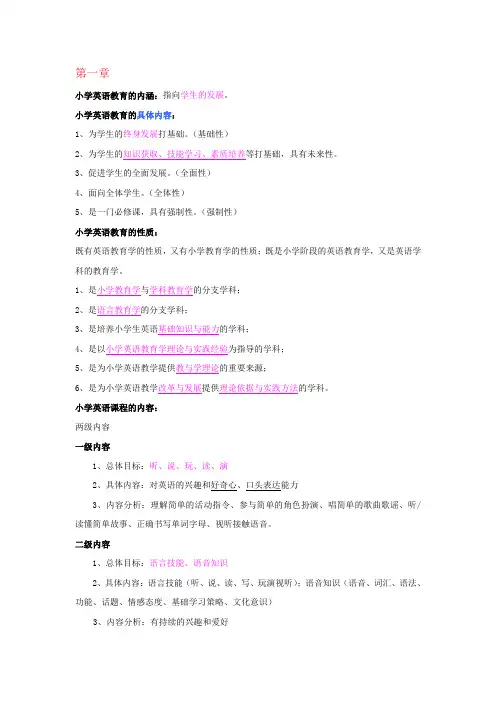
第一章小学英语教育的内涵:指向学生的发展。
小学英语教育的具体内容:1、为学生的终身发展打基础。
(基础性)2、为学生的知识获取、技能学习、素质培养等打基础,具有未来性。
3、促进学生的全面发展。
(全面性)4、面向全体学生。
(全体性)5、是一门必修课,具有强制性。
(强制性)小学英语教育的性质:既有英语教育学的性质,又有小学教育学的性质;既是小学阶段的英语教育学,又是英语学科的教育学。
1、是小学教育学与学科教育学的分支学科;2、是语言教育学的分支学科;3、是培养小学生英语基础知识与能力的学科;4、是以小学英语教育学理论与实践经验为指导的学科;5、是为小学英语教学提供教与学理论的重要来源;6、是为小学英语教学改革与发展提供理论依据与实践方法的学科。
小学英语课程的内容:两级内容一级内容1、总体目标:听、说、玩、读、演2、具体内容:对英语的兴趣和好奇心、口头表达能力3、内容分析:理解简单的活动指令、参与简单的角色扮演、唱简单的歌曲歌谣、听/读懂简单故事、正确书写单词字母、视听接触语音。
二级内容1、总体目标:语言技能、语音知识2、具体内容:语言技能(听、说、读、写、玩演视听);语音知识(语音、词汇、语法、功能、话题、情感态度、基础学习策略、文化意识)3、内容分析:有持续的兴趣和爱好英语课程设置的原则:整体性、多元性、灵活性实践要求:师范生应该能够较全面的理解具体内容与要求,并能够比较熟练地示范,如听录音后声情并茂地模仿,唱歌,说歌谣。
总之,要求学生做到的,老师必须要先做到。
中国英语教学存在的问题:问题一:费时多,收效微。
问题二:教师工作量太大,顾此失彼。
问题三:学生怕苦,兴趣不持久。
问题四:交际练习没有信息差,交际活动在不真实的语境中进行,学生在现实生活中不会运用。
问题五:家长水平有限,课后无法辅导。
问题六:教材难度大,学生消化不良。
问题七:教师英语素质不理想。
问题八:考评标准不标准,适用范围小。
问题九:缺乏真实环境语言环境,学而不用。
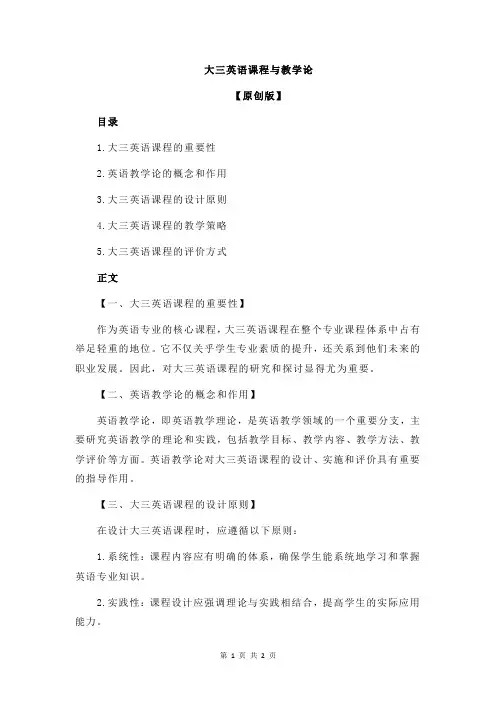
大三英语课程与教学论【原创版】目录1.大三英语课程的重要性2.英语教学论的概念和作用3.大三英语课程的设计原则4.大三英语课程的教学策略5.大三英语课程的评价方式正文【一、大三英语课程的重要性】作为英语专业的核心课程,大三英语课程在整个专业课程体系中占有举足轻重的地位。
它不仅关乎学生专业素质的提升,还关系到他们未来的职业发展。
因此,对大三英语课程的研究和探讨显得尤为重要。
【二、英语教学论的概念和作用】英语教学论,即英语教学理论,是英语教学领域的一个重要分支,主要研究英语教学的理论和实践,包括教学目标、教学内容、教学方法、教学评价等方面。
英语教学论对大三英语课程的设计、实施和评价具有重要的指导作用。
【三、大三英语课程的设计原则】在设计大三英语课程时,应遵循以下原则:1.系统性:课程内容应有明确的体系,确保学生能系统地学习和掌握英语专业知识。
2.实践性:课程设计应强调理论与实践相结合,提高学生的实际应用能力。
3.针对性:针对学生的实际情况和需求进行课程设计,满足他们的学习需求。
4.前瞻性:课程内容应具有一定的前瞻性,以适应社会发展的需要。
【四、大三英语课程的教学策略】在实施大三英语课程时,可采用以下教学策略:1.任务型教学法:通过设置具体的任务,引导学生主动参与学习,提高他们的学习兴趣和积极性。
2.合作学习:鼓励学生进行小组合作学习,培养他们的团队协作和沟通能力。
3.自主学习:培养学生的自主学习能力,引导他们通过多种途径和方法进行学习。
【五、大三英语课程的评价方式】在评价大三英语课程时,可采用多元化的评价方式,如:1.考试成绩:通过期中、期末等形式的考试,测试学生的专业知识掌握程度。
2.课堂表现:包括出勤率、课堂互动、课堂报告等方面。
3.实践作业:如课程论文、翻译作业等,检验学生的实际应用能力。

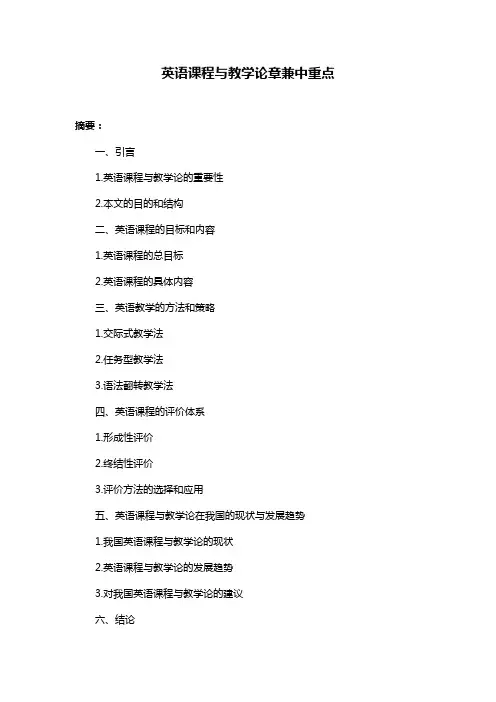
英语课程与教学论章兼中重点摘要:一、引言1.英语课程与教学论的重要性2.本文的目的和结构二、英语课程的目标和内容1.英语课程的总目标2.英语课程的具体内容三、英语教学的方法和策略1.交际式教学法2.任务型教学法3.语法翻转教学法四、英语课程的评价体系1.形成性评价2.终结性评价3.评价方法的选择和应用五、英语课程与教学论在我国的现状与发展趋势1.我国英语课程与教学论的现状2.英语课程与教学论的发展趋势3.对我国英语课程与教学论的建议六、结论1.英语课程与教学论的关键要点2.对英语教师和教育工作者的启示正文:英语课程与教学论是英语教育领域中的重要组成部分,它关注英语课程的设置、教学方法的选择、教学策略的制定以及课程评价等问题。
本文旨在通过对英语课程与教学论的研究,帮助英语教师和教育工作者更好地理解和应用英语教学理论和实践。
英语课程的总目标是培养学生的语言应用能力,使他们能在日常生活、学习和工作中熟练地使用英语进行交际。
为实现这一目标,英语课程设置了听、说、读、写、译等各方面的具体内容。
其中,听和说是英语教学的重点,也是学生最难掌握的部分。
在英语教学过程中,教师需要采用适当的教学方法和策略。
交际式教学法、任务型教学法和语法翻转教学法是三种常用的教学方法。
交际式教学法强调学生在语言交流中的主体地位,教师要为学生提供真实、自然的语言环境。
任务型教学法强调通过完成各种任务来培养学生的语言应用能力,教师要设计富有挑战性和实际意义的任务。
语法翻转教学法则要求教师将语法知识融入学生的语言实践中,让学生在实际运用中发现和掌握语法规则。
英语课程的评价体系包括形成性评价和终结性评价。
形成性评价主要通过课堂观察、学生作品、口语测试等方式进行,旨在了解学生的学习进度和成长需求。
终结性评价主要通过期末考试、升学考试等方式进行,旨在对学生的学习成果进行总结和鉴定。
评价方法的选择和应用要依据课程目标、教学内容和教学方法进行,力求全面、客观、公正。
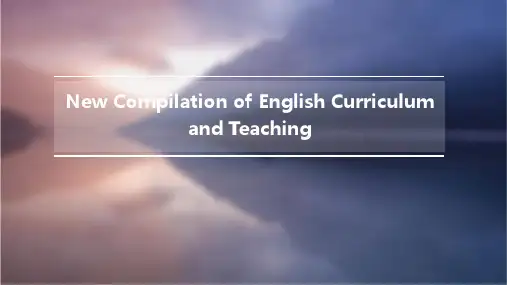
英语课程与教学论第二版课程内容摘要:一、引言二、英语课程与教学论第二版课程内容概述1.课程目标2.课程内容3.教学方法三、课程目标1.培养学生的英语语言能力2.发展学生的跨文化交际能力3.提高学生的综合素质四、课程内容1.语言知识与技能1.语音、语法、词汇2.听、说、读、写2.语言应用1.口语交际2.书面表达3.文化与跨文化交际4.语言学习策略五、教学方法1.任务型教学法2.交际式教学法3.情境教学法4.自主学习法六、结论正文:英语课程与教学论第二版课程内容主要针对培养学生的英语语言能力、发展学生的跨文化交际能力以及提高学生的综合素质这三个方面进行设计。
课程内容涵盖了语言知识与技能、语言应用、文化与跨文化交际以及语言学习策略等方面。
在教学方法上,采用了任务型教学法、交际式教学法、情境教学法和自主学习法等多种教学方法。
首先,课程目标是培养学生的英语语言能力,使他们能够运用英语进行有效的沟通。
课程内容在语音、语法、词汇等方面进行训练,以提高学生的听说读写能力。
此外,课程还注重培养学生的跨文化交际能力,使他们能够在不同文化背景下进行有效沟通。
为了实现这一目标,课程内容涵盖了文化与跨文化交际方面,帮助学生了解不同文化背景下的交际习惯。
其次,课程内容还包括语言应用方面的训练,如口语交际和书面表达。
通过这些内容的学习,学生可以提高自己的英语应用能力,更好地应对实际交际场景。
此外,课程还注重培养学生的综合素质,使他们能够在学习英语的过程中,养成良好的学习习惯,提高自己的学习效率。
在教学方法上,课程采用了任务型教学法、交际式教学法、情境教学法和自主学习法等多种教学方法。
任务型教学法可以帮助学生在完成具体任务的过程中,提高自己的英语能力;交际式教学法则强调学生在实际交际场景中运用英语,提高他们的语言应用能力;情境教学法通过创设生动的情境,让学生在真实的语境中学习英语;自主学习法则鼓励学生主动探索、独立学习,培养他们的自主学习能力。
英语课程与教学论一、名词解释5*4’二、简答题4*5’三、论述题2*15’四、综合应用题20’+10’名词解释1.Receptive/passive vocabulary: refers to words that one is able to recognise and comprehend in reading or listening but unable to use automatically in speaking or writing.2.Connotative meaning: A connotative meaning of a world refers to “the attitudes or emotions of a language user in choosing a word and the influence of these on the listener or reader’s interpretation of the word.3.Scanning: The type of pre-reading activity is scanning, which means to read to locate specific information. The key point in scanning is that the reader has something in his mind and he should ignore the irrelevant parts when reading.4.Bottom-up model: Some teacher teach reading by introducing new vocabulary and paragraph with the students. This is then followed by questions and answers to check comprehension. Also a lot of time is spent on having students read aloud the text. This way of teaching reflects the belief that reading comprehension is based on the mastery of the new words and new structures as well as a lot of reading aloud practice. It basically follows a linear process from the recognition of letters to words, to phrases, to sentences, to paragraphs, and then to the meaning of the whole text. This way of teaching is known to follow a bottom-up model.5.Pragmatic competence: is concerned with the appropriate use of the language in social context. That is to say, the choice of the vocabulary and structure depends on the setting, the relative status of speakers, and their relationships.简答题1.Developing vocabulary learning strategies(1)Review regularly(2)Guess meaning from context(3)Organise vocabulary effectively(4)Use a dictionary(5)Manage strategy use2.判断原则(1)Communicative purpose: The activity must involve the students in performing a real communicative purpose rather than just practising language for its own sake. In order for this to occur there must be some kind of ‘information gap' that students seek to bridge when they are communicating.(2)Communicative desire: The activity must create a desire to communicate in the students.That is, even if communication is forced on the students, they must feel areal need to communicate.(3)Content,not form: When the students are doing the activity, they must be concentrating on what they are saying, not how they say it. They must have some 'message' that they want to communicate.(4)Variety of language: The activity must involve the students in using a variety of language, not just one specific language form. The students should feel free to improvise, using whatever resources they choose.(5)No teacher intervention: The activity must be designed to be done by the students working by themselves rather than with the teacher. The activity should not involve the teacher correcting or evaluating how the students do the activity when the activity over. This assessment should be based on whether the students have achieved their communicative purpose, not whether the language they used was correct.(6)No material control: The activity should not be designed to control what language students should use. The choice about what language to use should rest with the students.ponents of a lesson plan(1)Background information(2)Teaching aims(3)Language contents and skills(4)Stages and procedures(5)Teaching aids(6)End of lesson summary(7)Optional activities and assignments(8)After lesson reflection4.Characteristics of tasks in TBLT论述题1.Characteristics of tasks(1)one-way or two-way: whether the task involves one-way of exchange of information or two-way of exchange;(2)convergent or divergent: whether the students achieve a common goal or different several goals;(3)Collaborative or competitive: whether the students collaborate to carry out a task or compete with each other on a task;(4)Single or multiple outcomes: whether there a single outcome or many different outcomes are possible;(5)Concrete or abstract language: whether the task involves the use of concrete language or abstract language;(6)Simple or complex processing: whether the task requires the relatively simple or complex cognitive processing;(7)Simple or complex language: whether the linguistic demands of the task are relatively simple or complex;(8)Reality-based or not reality-based: whether the task mirrors a real-world activity or is a pedagogical activity not found in the real world.2.自由发挥综合应用题1.教案2.Decision-making test。
小学英语课程与教学论一、引言英语作为一门国际通用语言,在中国的教育体系中具有重要地位。
在小学英语课程与教学中,教师的教学方法和课程设计对学生的英语学习效果起着至关重要的作用。
本文将从小学英语课程的设计和教学方法的选择两个方面分析小学英语课程与教学的论述。
二、小学英语课程设计小学英语课程的设计应结合大纲的要求,合理安排各个学习阶段的教学内容和目标。
以下是小学英语课程设计的几个关键要素:2.1 学习目标小学英语课程的学习目标应该明确具体。
根据学生的年龄和学习能力,可以将学习目标分为听、说、读、写四个方面。
比如,在一年级,学生的学习目标可以是基本的英语听力和口语表达能力,而在三年级,则可以增加阅读和书写能力的要求。
2.2 教学内容小学英语课程的教学内容应该基于学生的实际需求和兴趣。
可以选择那些与学生日常生活密切相关的主题,比如家庭、学校、朋友等。
同时,也要注意教学内容的递进性,确保每个学习阶段的内容能够有机衔接起来,让学生能够循序渐进地提升英语能力。
2.3 教学方法小学英语课程的教学方法应灵活多样,使学生能够以兴趣为驱动,主动参与课堂。
可以运用游戏、故事、歌曲等多种形式,增加趣味性和互动性。
同时,也要注重培养学生的听、说、读、写能力,针对不同学习目标采取相应的教学策略。
三、小学英语教学方法的选择小学英语教学方法的选择应根据学生的特点和学习目标进行有针对性的安排。
以下是几种常用的小学英语教学方法:3.1 游戏化教学法游戏化教学法是小学英语教学中常用且有效的方法之一。
通过设计各种语言游戏,如角色扮演、拼图等,让学生在互动中学习英语,提高学习效果。
游戏化教学法能够激发学生的兴趣,增加学习的乐趣,培养学生的合作意识和团队精神。
3.2 故事教学法故事教学法通过讲述精彩的英语故事,激发学生的阅读兴趣和想象力,在培养学生对英语的理解和运用能力的同时,也加强了学生对英语文化的认知。
通过故事教学法,学生能够通过情节和人物的塑造逐步掌握英语的语法和词汇,提高英语的听、说和读的能力。
《小学英语课程与教学论》课程大纲一、课程概述本课程是为教育学专业准备从事小学英语教育的学生开设的一门专业课,也是英语教师职业培训的核心内容之一,旨在帮助学生掌握英语教学的最新理论和主要方法。
而“小学英语课程与教学论”课程与普通英语课程与教学论课程既有融会贯通之处,又有本门学科独特的特点。
了解6-13岁儿童的思维发展和语言学习特点,才能更好地运用英语教学方法于课堂教学中。
1.课程描述“小学英语课程与教学论”是教育学专业国际教育方向的必修课之一,这是一门理论性、实践性并重的课程,注重促进学生自身能力的提高,为今后进入小学从事英语教育和研究工作以及专业的学习打下良好的基础。
这门课程在教学中要求以培养学习者的教学实际能力为主,但也不能忽视对英语教学相关理论和方法的学习和理解。
其主要内容包括:新课程的价值和小学新英语课程的教学内容;主要教学法流派;教学设计;听、说、读、写教学能力培养;教学评价和小学英语教师基本素质等。
2. 设计思路本课程是通过教学和教育、教学实践的方法来培养学生,使他们懂得学英语的原理,掌握教授英语的方法,明确小学英语教学的目的,具有分析教材和常规教学的能力,并且能够进行对小学英语教学中的规律作初步的研究,使学生了解国家英语新课程标准和英语课程的基本理念;掌握基本的教学技能和课堂操作技巧;使他们具备小学英语教师所应具备的各种素养。
讲授为主,采用启发式、互动式、讨论式和反思式的教学方法,以任务型活动和理论与实践的反馈方式为设计模式;辅以观看小学英语课例,专题讨论,课堂试讲和小学实习。
3.本课程与专业人才培养目标的关系4. 本课程与其它课程的关系5. 学习后的总体目标通过本课程的学习,学生能够达到的总体目标为:懂得学英语的原理,掌握教授英语的方法,明确小学英语教学的目的,具有分析教材和常规教学的能力,并且能够进行对小学英语教学中的规律作初步的研究,了解国家英语新课程标准和英语课程的基本理念;掌握基本的教学技能和课堂操作技巧;具备小学英语教师所应具备的各种素养。
判断1.()小学英语课程是面向全体学生的课程,着眼于全人的教育2.()全人教育应该由六个方面组成,即学问、道德、艺术、宗教、建筑和生活。
3.()“从对话中选出重要词汇和语法进行练习”这种课堂教学实践体现了功能语言观。
4.()“通过听和模仿,形成正确的语言习惯”这种课堂教学实践体现了互动语言观。
5.()第一语言也可称为母语。
6.()狭义的第二语言指除母语之外,在官方,商业及社会中广泛应用的语言。
7.()习得(acquisition)又叫获得,是儿童在自然的语言环境中,不经过正式的教授而自然地,下意识地获得语言的过程。
8.()学习(learning)是指儿童在非正式的语言环境下有意识地、系统地、正规地学习语言的过程。
9.()克拉申认为成人通过两种不同而又独立的途径学会外语。
10.()克拉申语言习得理论认为语言学习者应获得略高于其现有语言水平的第二语言输入。
11.()斯金纳基于动物行为反应的理论提出行为主义语言学习理论。
12.()行为主义认为语言是一种人类行为,而不是一种思维现象。
13.()刺激——反应理论是认知主义学习理论的基础。
14.()根据行为主义理论的观点,儿童的语言环境对其母语习得起决定性的作用。
15.()语言行为既受语言环境的影响,也受说话人自身心理因素的影响。
16.()中介语是指第二语言学习者建构起来的介于母语和目的语之间的过渡性语言。
17.()隐性知识是以书面文字、图表和数学公式加以表述的知识。
18.()中介语的三个特征是可渗透性、可变性和系统性。
19.()僵化现象是指某些非目的语的语法、语音等长期存在于中介语中,并且不易改变的现象。
20.()小学生思维特点以抽象思维为主。
21.()在小学英语教学中,教师以培养小学生兴趣为主。
22.()为了延长小学生注意时间,小学英语教师应采用单一的教学方式。
23.()为了充分发挥小学生善于模仿的特点,小学英语教师要重视读写作用。
24.()影响儿童英语学习最终效果的个体因素主要是情感因素。
《英语课程与教学论》课程简介本课程重点探讨语言与语言教师、语言学习理论与学习者、英语课程标准与教材、英语知识与技能的教学、备课与课程管理、课堂教学评价与反思以及现代教育技术与教学资源等七个方面。
本课程分为七个单元,每单元整合两个专题,采取导文、导文提示、文献阅读、观察与思考(课堂实录)以及任务活动等新颖的形式,把学术性、实用性、趣味性和互动性很好地结合起来。
其目的是确定英语教师专业知识结构的共核,帮助英语教师从其中一点出发,走向专业化发展道路。
-----------------------------------------------------------------------------------------------------单元一第一部分语言与语言教师Language and language teachers导文 1 Lead-inWhat is a language?What do people know when they know a language? You would think that this is an easy question to answer, since, as speakers of it, we all use our language frequently.The situation is rather like driving a car.Many people drive a car perfectly well without knowing how the car works.In the case of languages, the situation is more difficult in that languages are not physical objects like a car.They exist only within the minds of speakers.There are many theories about how language works, but the more language is studied,the more complex it seems to become.Kuiper, K.& Allan, W.S.2004:1【导文提示Hints 】对于语言观和语言教学观,人们持有不同看法。
英语课程与教学论一、名词解释5*4’二、简答题4*5’三、论述题2*15’四、综合应用题20’+10’名词解释1.Receptive/passive vocabulary: refers to words that one is able to recognise and comprehend in reading or listening but unable to use automatically in speaking or writing.2.Connotative meaning: A connotative meaning of a world refers to “the attitudes or emotions of a language user in choosing a word and the influence of these on the listener or reader’s interpretation of the word.3.Scanning: The type of pre-reading activity is scanning, which means to read to locate specific information. The key point in scanning is that the reader has something in his mind and he should ignore the irrelevant parts when reading.4.Bottom-up model: Some teacher teach reading by introducing new vocabulary and paragraph with the students. This is then followed by questions and answers to check comprehension. Also a lot of time is spent on having students read aloud the text. This way of teaching reflects the belief that reading comprehension is based on the mastery of the new words and new structures as well as a lot of reading aloud practice. It basically follows a linear process from the recognition of letters to words, to phrases, to sentences, to paragraphs, and then to the meaning of the whole text. This way of teaching is known to follow a bottom-up model.5.Pragmatic competence: is concerned with the appropriate use of the language in social context. That is to say, the choice of the vocabulary and structure depends on the setting, the relative status of speakers, and their relationships.简答题1.Developing vocabulary learning strategies(1)Review regularly(2)Guess meaning from context(3)Organise vocabulary effectively(4)Use a dictionary(5)Manage strategy use2.判断原则(1)Communicative purpose: The activity must involve the students in performing a real communicative purpose rather than just practising language for its own sake. In order for this to occur there must be some kind of ‘information gap' that students seek to bridge when they are communicating.(2)Communicative desire: The activity must create a desire to communicate in the students.That is, even if communication is forced on the students, they must feel areal need to communicate.(3)Content,not form: When the students are doing the activity, they must be concentrating on what they are saying, not how they say it. They must have some 'message' that they want to communicate.(4)Variety of language: The activity must involve the students in using a variety of language, not just one specific language form. The students should feel free to improvise, using whatever resources they choose.(5)No teacher intervention: The activity must be designed to be done by the students working by themselves rather than with the teacher. The activity should not involve the teacher correcting or evaluating how the students do the activity when the activity over. This assessment should be based on whether the students have achieved their communicative purpose, not whether the language they used was correct.(6)No material control: The activity should not be designed to control what language students should use. The choice about what language to use should rest with the students.ponents of a lesson plan(1)Background information(2)Teaching aims(3)Language contents and skills(4)Stages and procedures(5)Teaching aids(6)End of lesson summary(7)Optional activities and assignments(8)After lesson reflection4.Characteristics of tasks in TBLT论述题1.Characteristics of tasks(1)one-way or two-way: whether the task involves one-way of exchange of information or two-way of exchange;(2)convergent or divergent: whether the students achieve a common goal or different several goals;(3)Collaborative or competitive: whether the students collaborate to carry out a task or compete with each other on a task;(4)Single or multiple outcomes: whether there a single outcome or many different outcomes are possible;(5)Concrete or abstract language: whether the task involves the use of concrete language or abstract language;(6)Simple or complex processing: whether the task requires the relatively simple or complex cognitive processing;(7)Simple or complex language: whether the linguistic demands of the task are relatively simple or complex;(8)Reality-based or not reality-based: whether the task mirrors a real-world activity or is a pedagogical activity not found in the real world.2.自由发挥综合应用题1.教案2.Decision-making test。